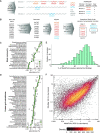Reconstructing the landscape of gut microbial species across 29,000 diverse individuals
- PMID: 37070603
- PMCID: PMC10201371
- DOI: 10.1093/nar/gkad249
Reconstructing the landscape of gut microbial species across 29,000 diverse individuals
Abstract
The human gut microbiome has been linked to health and disease. Investigation of the human microbiome has largely employed 16S amplicon sequencing, with limited ability to distinguish microbes at the species level. Herein, we describe the development of Reference-based Exact Mapping (RExMap) of microbial amplicon variants that enables mapping of microbial species from standard 16S sequencing data. RExMap analysis of 16S data captures ∼75% of microbial species identified by whole-genome shotgun sequencing, despite hundreds-fold less sequencing depth. RExMap re-analysis of existing 16S data from 29,349 individuals across 16 regions from around the world reveals a detailed landscape of gut microbial species across populations and geography. Moreover, RExMap identifies a core set of fifteen gut microbes shared by humans. Core microbes are established soon after birth and closely associate with BMI across multiple independent studies. RExMap and the human microbiome dataset are presented as resources with which to explore the role of the human microbiome.
© The Author(s) 2023. Published by Oxford University Press on behalf of Nucleic Acids Research.
Figures





Similar articles
-
Quantitative Assessment of Shotgun Metagenomics and 16S rDNA Amplicon Sequencing in the Study of Human Gut Microbiome.OMICS. 2018 Apr;22(4):248-254. doi: 10.1089/omi.2018.0013. OMICS. 2018. PMID: 29652573
-
Ecophylogenetics Clarifies the Evolutionary Association between Mammals and Their Gut Microbiota.mBio. 2018 Sep 11;9(5):e01348-18. doi: 10.1128/mBio.01348-18. mBio. 2018. PMID: 30206171 Free PMC article.
-
High-resolution ISR amplicon sequencing reveals personalized oral microbiome.Microbiome. 2018 Sep 5;6(1):153. doi: 10.1186/s40168-018-0535-z. Microbiome. 2018. PMID: 30185233 Free PMC article.
-
Analysis of the microbiome: Advantages of whole genome shotgun versus 16S amplicon sequencing.Biochem Biophys Res Commun. 2016 Jan 22;469(4):967-77. doi: 10.1016/j.bbrc.2015.12.083. Epub 2015 Dec 22. Biochem Biophys Res Commun. 2016. PMID: 26718401 Free PMC article.
-
Cocoa seeds and chocolate products interaction with gut microbiota; mining microbial and functional biomarkers from mechanistic studies, clinical trials and 16S rRNA amplicon sequencing.Crit Rev Food Sci Nutr. 2024;64(10):3122-3138. doi: 10.1080/10408398.2022.2130159. Epub 2022 Oct 3. Crit Rev Food Sci Nutr. 2024. PMID: 36190306 Review.
References
Publication types
MeSH terms
Substances
Grants and funding
LinkOut - more resources
Full Text Sources

